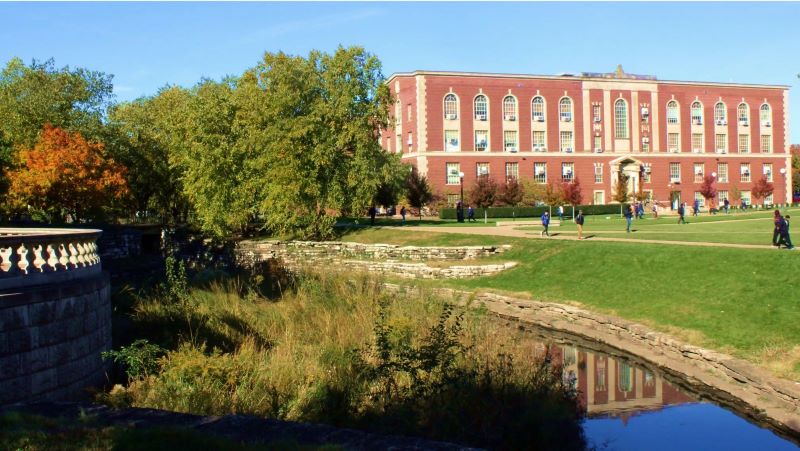A response to Carbon or Radiation?: A false dilemma.
Climate change is an existential threat to humanity. We must use every tool at our disposal to halt and reverse the already damaging impacts of this crisis. The University of Illinois recognizes this, and also recognizes its role in reducing carbon emissions. In 2015, the Illinois Institute for Sustainability, Energy, and Environment (iSEE) published its second version of the Illinois Climate Action Plan (iCAP). This plan set a goal to make the U of I carbon neutral by 2050, which includes every scope of emissions; from energy production to the transportation faculty and staff use to get to work. Carbon neutrality is both an ambitious and admirable goal, but it is not easy (otherwise, there would be no climate crisis). U of I is uniquely challenging because most of the campus buildings are heated through district heating, by using steam directly from the campus power plant, Abbott. Generating steam is quite easy for a thermal plant, such as coal, natural gas, or even nuclear. But it is difficult and costly to generate through electricity.
The 2015 iCAP report specifically mentions nuclear energy as a possible mitigation strategy because they produce zero greenhouse gases and can easily replace the steam from Abbott Power Plant. The 2020 iCAP report released just last month went even further, stating: “Another potential clean energy solution that can be implemented at Abbott is portable Advanced Small Modular Reactors.” “Clean energy” refers to any source that does not produce greenhouse gases or pollute the atmosphere. The report went on to acknowledge the work that the Department of Nuclear, Plasma, and Radiological Engineering (NPRE) and project proposal team was doing to collaborate with key stakeholders. The project proposal team maintained an emphasis on connecting and engaging with the community throughout the process. They have hosted multiple Ask-Me-Anything forums on Reddit and also hosted a town-hall over Zoom that is available on YouTube, all publicly advertised. The proposed reactor (which was not awarded by the Department of Energy this time around) was primarily intended for education and research. Had it been awarded, there would have been several stages of community involvement. If you have concerns about nuclear energy on campus, the Nuclear Powered UIUC proposal team wants to hear them.
There are some common fears about nuclear energy. First is the risk of radiation from living near a nuclear power plant. This infographic from the University of California shows that the dose from living within 50 miles of a plant for an entire year is 400 times less than one cross country plane ride. There is natural background radiation passing through your body all the time and the dose changes depending on your geography. Compared to living near a nuclear plant, living in Denver will increase your background dose by 1000 times. Also, replacing a coal plant, such as Abbott, with a nuclear one reduces background radiation levels. The dilemma of choosing carbon or radiation is not just false, it’s nonexistent.
Second is the possibility of a nuclear meltdown. Fortunately, U of I has a history of safely operating a TRIGA research reactor for 38 years. Further, they have demonstrated that it can safely decommission a microreactor too when it shut down the TRIGA reactor in 1998. The proposed reactor was of a comparable size to the retired TRIGA reactor. The University and its surrounding community is not now and will never be a “Superfund” site. The reactor design proposed by the Ultra-Safe Nuclear Corporation is guaranteed by physics to contain fission products in every accident scenario. Humans are fallible, physical laws are not.
The final issue is handling the spent fuel. Contrary to popular belief, spent fuel storage has been a solved problem for almost 40 years. Dry cask storage is the current common practice in the United States that uses practically indestructible containers. France has been recycling their fuel for decades. Whatever happens to the spent fuel will ultimately be decided by the Department of Energy, guided by community feedback and relevant science.
Is nuclear power generation the most dangerous form of energy production? Far from it. Nuclear energy is as safe or safer than every other form of energy generation. This includes the oft-cited accidents at Three Mile Island, Chernobyl, and Fukushima. Nuclear meltdowns alone do not imply dangerous releases of radiation. There were no adverse health effects found in the community surrounding Three Mile Island and the accident at Fukushima did not increase cancer risk, nor did it cause any acute radiation poisoning. The area around both Three Mile Island and Fukushima are very much still habitable and inhabited. Let me state clearly: These accidents should not have happened. That they occurred and lead to few, if any, negative health outcomes is a testament to the robustness of nuclear energy. Chernobyl is considered separately because the design, operating, and human flaws that lead to the accident are impossible in the United States.
Rather than shelving other solutions, a microreactor could give the University of Illinois the flexibility to explore many avenues and policies to achieve its climate goals. It would have also provided exciting opportunities for education and research. Most of the students I know in the NPRE department, myself included, chose to study nuclear engineering from a strong desire to keep our environment clean and our people healthy. Nuclear reactors are among the safest and cleanest forms of energy production.








